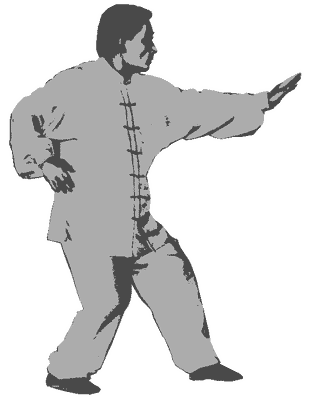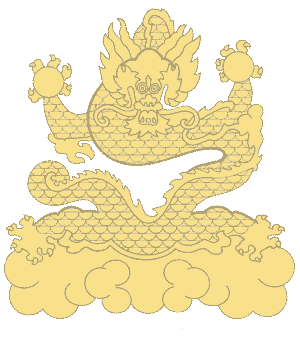Master Chen Xiao Wangs' long awaited 1996 tour of the US began with
a two day seminar in New York City on July 20 & 21. The subject
of the seminar was Developing Internal Strength and Chen style Silk
Reeling Exercises.
Master Chen was hosted by his senior student, Master Ren Guangyi,
of Flushing, NY.Master Chen Xiao Wang is one of the most famous living
Taiji practitioners in the world. As the 19th generation standard
bearer of Chen family Taijiquan, he is a living legend among practitioners
of the art. Da Shr (grandmaster) Chens' visit to New York ( and subsequent
visits to Denver and San Francisco) was a truly unique opportunity
for Taiji enthusiasts to meet and study with one of the worlds' foremost
authorities on the art.
Master Chens' manner was friendly, dignified, and gracious. He sat
patiently for numerous photos, and answered all questions presented
to him by students. In teaching, he was serious, but easygoing. He
entertained the seminar with several amusing stories to illustrate
various points in his presentation.
In his opening remarks, Master Chen thanked the seminar participants
for their support of Taiji, and encouraged them to greater heights
in their practice. He described the seminar curriculum, stressing
that while few techniques would be covered, they would be dealt with
in depth. in this way, he would teach the basic principles of correct
Taiji practice, which could then be applied to other movements.
In his introduction, Master Chen noted that Chan Ssu (reeling silk)
is the basic principle of Taiji. It appears simple, but to do it correctly
requires much practice. It is the most important aspect of Taijiquan.
It is practiced by applying basic principles to basic movements. If
reeling silk is understood, then the principles of movement in Taiji
are clear. Chan Ssu is the standard for Taiji. It is necessary to
understand the relationship between the principles of chan ssu and
the movements of Taiji. It should be noted that the standard for Taiji
is not any one teacher or person: the standard is correct Taiji principles.
If the standard is known and understood, incorrect practice can be
discerned in yourself and others. Many people who practice Taiji,
even in China, don't understand this. They follow blindly and slavishly
the movements of a particular teacher without analyzing them in the
light of correct principles. Some teachers have incorrect movement,
and pass it on to their students. Master Chen noted a story of one
teacher in Singapore who injured his leg, and as a result, could not
kick without causing pain. This made him wince. His students all adopted
the habit of wincing when they kicked.
To practice in an incorrect manner will not yield the heath benifits
that Taiji is noted for. Master Chen noted that when learning it is
natural that practice will not, at first, be entirely correct. If
you understand and daily strive to apply the basic principles to your
practice, your movement will gradually approach the correct form.
Taiji is a science and an art: all can learn it and benefit from it.
When practicing, the length and level of the stance and the posture
must be adjusted to fit the practitioners body type and strength.
Movement should not be forced or uncomfortable. This will allow Qi
to circulate thru the body freely.
Master Chen began by instructing the group in the practice of Zhan
Zhuang (pile standing). The practice of Zhan Zhuang facilitates the
centering of Qi in the tantien. It was noted that this does not mean
that all of the bodys' qi should go to the tantien: but that the mridians
and channels leading out from the tan tien are open. If this occurs,
the qi in the tantien will be strong. As a result, the practitioner
feels exuberant and strong. Master Chen noted that masters can tell
when they are dying by the feeling of qi dispersing from their tantien.
Therefore, the first aim of Zhan zhuang is to preserve the preheaven
qi, and increase the post heaven qi. The postural alignments of Zhan
Zhuang allow the tantien to become totally relaxed, and to be the
center of qi in the body. In instructing Zhan Zhuang, Master Chen
emphasized three aspects: balancing the mind, balancing the weight,
and balancing the qi.
When practicing, the chest should feel loose and relaxed, while the
tantien feels full. A feeling of tension in the tantien signifies
that it is closed: if this occurs, qi will rise to the chest, making
it feel uncomfortable and full. When practising correctly, the tantien
feels full, and the kidneys feel warm. the body will feel full of
energy.
Master Chen stressed that when standing, the line from the ears to
the hips to the ankles should not be broken. One should relax, but
not limply; do so in the context of correct structure.
After practice of Zhan Zhuang, Master Chen moved on to the practice
of Chan Ssu Gong, or "Reeling Silk". He noted that movement
should be relaxed, natural, and flowing. One should not exert oneself
during practice. The goal is to make the tantien the center and originator
of each movement. In order to accomplish this, one must have correct
postural alignment. Master Chen reiterated the postural alignments
taught in Zhan Zhuang as the basic foundation for Chan Ssu Gong.
It was stressed that the body follows the movement of the waist. All
movements must utilise a spiral. Master Chen then demonstrated the
various ways in which the tantien can rotate to initiate various movements
in the Chen style. He noted that while qi circulates as a result of
tantien movement, the qi of the tantien does no move from the tantien.
He then illustrated the basic path of qi in Chan Ssu Gong practice:
from the tantien to the back/mingmen, from the back to the fingers,
from the fingers to the waist, and from the waist to the tantien.
This explanation was expounded on as Master Chen instructed the class
in basic silk reeling exercises, such as the single handed, stepping
single handed, double handed, stepping double handed, and backward
stepping double handed exercises.
The seminar was punctuated by a demonstration by Master Chen of a
segment of his 38 posture form, and also by a photo session. Master
Chen concluded the seminar with an admonition to the class to practice
diligently. He is considering a return visit next year.
|



